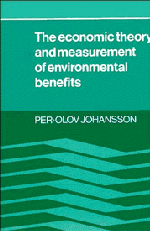Book contents
- Frontmatter
- Contents
- Preface
- 1 Introduction
- 2 Some basic concepts
- 3 The concept of consumer surplus
- 4 Topics in the theory of consumer surplus measures
- 5 Consumer surplus measures in quantity-constrained regimes
- 6 Public goods and externalities in consumption
- 7 How to overcome the problem of preference revelation; practical methodologies
- 8 Discrete choice models and environmental benefits
- 9 Consumer's surplus in an intertemporal context
- 10 Welfare change measures in a risky world
- 11 Money measures of the total value of environmental assets
- Notes
- Bibliography
- Index
5 - Consumer surplus measures in quantity-constrained regimes
Published online by Cambridge University Press: 10 January 2011
- Frontmatter
- Contents
- Preface
- 1 Introduction
- 2 Some basic concepts
- 3 The concept of consumer surplus
- 4 Topics in the theory of consumer surplus measures
- 5 Consumer surplus measures in quantity-constrained regimes
- 6 Public goods and externalities in consumption
- 7 How to overcome the problem of preference revelation; practical methodologies
- 8 Discrete choice models and environmental benefits
- 9 Consumer's surplus in an intertemporal context
- 10 Welfare change measures in a risky world
- 11 Money measures of the total value of environmental assets
- Notes
- Bibliography
- Index
Summary
In many situations individuals could be expected to face quantity constraints. Governments, for example, sometimes impose price ceilings or floors which result in excess demand or supply in markets for goods and factors. In other circumstances quotas are imposed. This is sometimes the case when drugs or chemicals are considered harmful and consumption is therefore restricted; possibly a total ban is imposed.
Quantity constraints are also of considerable importance in the analysis of recreation activities. For example, U.S. waterfowl hunters face three different quantity constraints or institutional limits. These are the maximum number of waterfowl that may be bagged in one day, the maximum number of days during which waterfowl may be shot, and the maximum number of birds a hunter may have in his possession (Hammack and Brown, 1974, p. 18). Similarly, the carrying capacity of a natural area for recreational activities may be limited so that the number of visitors must be restricted. In order to be useful in such situations, the consumer surplus measures, derived in the previous chapters, need to be modified.
The seminal work on utility maximization subject to quantity constraints is that of Tobin and Houthakker (1950/1). They examined a situation where constraints are just on the verge of binding at the examined point. More recently, the Tobin–Houthakker results have been generalized to situations where the rationing constraints are not optimal (see Howard, 1977; Mackay and Whitney, 1980; Neary and Roberts, 1980).
- Type
- Chapter
- Information
- Publisher: Cambridge University PressPrint publication year: 1987



